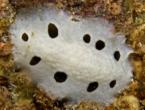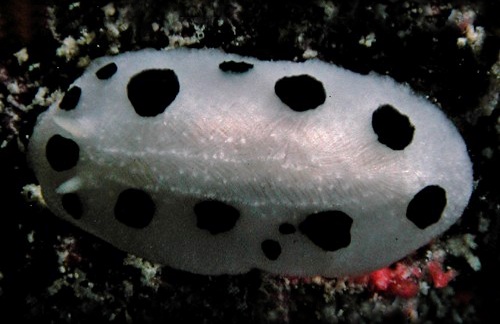| Home |
| Acknowledgments |
| Conventions |
| Glossary |
| Maps |
| References |
| Links |
| Articles |
| Thumbnails |
| Species
list |
| Family |
| Next
species |
Additional Photos

dusky rhinophores

more spots

Phyllidiopsis loricata (Bergh, 1873)

| Maximum size: 19 mm. (David reported his animal as "20-25 mm") Identification: This species has a white body, typically with 8-10 large black spots encircling the mid-dorsal area and smaller spots scattered randomly among them. The notum is opaque-white becoming translucent-white around the mantle margin. Upon close examination, iridescent striae can be seen in the center of the notum representing embedded spicules radiating from the midline. Many tiny tubercles cover the notum and line up medially in several low, longitudinal ridges giving the animal a rough appearance. The fused oral tentacles are very large for the animal’s size. It can be distinguished from Phyllidia scottjohnsoni by the lack of black spots mid-dorsally and the presence of fused oral tentacles. Natural history: Phyllidiopsis loricata is a rare species found under rocks or on shaded walls in moderately protected to highly exposed locations from 4-43 m (20-141 ft). We have observed it on a white sponge. (Note 1) Distribution: Big Island, Maui and Oahu: widely distributed in the Indo-Pacific. Taxonomic notes: It was first recorded in Hawaii at Pupukea, Oahu by Scott Johnson on July 2, 1979. The name means “equipped with a piece of close-fitting armor,” perhaps for the rough appearance of the notum. It's referred to as the "armored Phyllidia" in the 2019 printing of Hoover, 2006. Photo: Mike Severns: 18 mm: Maalaea Bay, Maui; Sept. 21, 1987. Observations and comments: Note 1: Keoki Stender also illustrates it on white sponges on his site and suggests that it may feed on Leiodermatium sp. although the identity of the sponges in the photos is somewhat uncertain... |
| Thumbnails |
Species
list |
Family | Next species | Top |